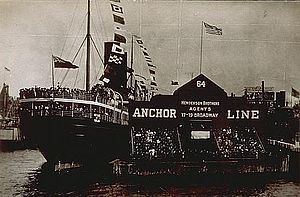Yard number 459 Launched 9 July 1906 Draft 10 m | Construction started 1904 Length 143 m | |
 | ||
Port of registry | ||
The twin screw steamer California was built by D & W Henderson Ltd, Glasgow for the Anchor Line Ltd in 1907 as a replacement for the aging ocean liner Astoria, which had been in continuous service since 1884. She worked the Glasgow to New York transatlantic route and was sunk by the German submarine SM U-85 on 7 February 1917.
Contents
Building
SS California was 8,662 GRT (6,791 under deck and 5,403 net), with a length of 470 feet (140 m), a beam of 58.3 feet (17.8 m) and a draught of 34 feet (10 m). The California had three decks: the poop deck was 70 feet (21 m) long, the bridge 213 feet (65 m) long and the forecastle 91 feet (28 m) long. She had two black funnels, two giant masts (one fore and one aft), twin screw propeller propulsion and was capable of achieving a speed of 16 knots (30 km/h). She was fitted with a triple expansion engine with 6 cylinders of 27 1⁄2, 46 and 75 inches each pair; it had a stroke of 54 inches and produced 827 nominal horsepower. The engine was built by the same company that built her hull. The ship was capable of carrying a total of 1214 passengers: 232 first class, 248 second class and 734 third class. She was outfitted with the latest appointments, including electric light and refrigerating machinery.
Launch
She was officially launched on 9 July 1907, having been christened by the Lady Ure Primrose, wife of Sir John Ure Primrose, Lord Lieutenant of the County of the City of Glasgow. Captain J Blaikie was appointed to the ship that same year. She was given the call sign "HLQJ", and the official registration number 124230. Her maiden transatlantic voyage from Glasgow to New York began on 12 October 1907.
Grounding on Tory Island
On 28 June 1914 California ran aground on Tory Island off the north-west coast of Ireland in dense fog with over 1,000 passengers on board. The ship’s bows caved in upon impact, and though she took on water through two holes in her hold she remained above water. Three British warships including the destroyer Swift, as well as the ocean liner Cassandra, aided the stricken vessel and assisted in transferring stranded passengers back to shore. The ship was towed back to Glasgow on 20 August 1914, and less than two months later was repaired and refloated. She resumed Glasgow - Liverpool - New York sailings for the Cunard - Anchor joint service on 13 October 1915.
Fire in Manhattan
Shortly after 8 pm on 13 May 1916 a fire began in her Number 1 cargo hold as she was docked at Pier 64 on the North River in Manhattan. Of great concern to the first responders and her crew was that she was in the process of being loaded up with, amongst other things, highly volatile war munitions destined for Liverpool, England. The quick action of the Superintendent of the Pier, and his subsequent sounding of the alarm, led to a quick response by a nearby fireboat that assisted the crew in fighting the blaze. The fire was successfully extinguished shortly after 1030 pm that same night. The fire was ultimately deemed accidental, and as the damage was minimal, she set sail the following Monday as scheduled. Had the fire not been noticed by the superintendent in time, or had the ship been fully loaded with munitions when the fire erupted, the ship and surrounding section of Manhattan might have sustained a catastrophe comparable to the Halifax Explosion.
Loss
California sailed on her last Glasgow to New York voyage on 12 January 1917. She began her return voyage on 29 January 1917 with 184 crew and 31 passengers on board. On 3 February 1917, as she sailed on her return trip towards Scotland, German U-boats attacked and sank the SS Housatonic, an act which led to the breaking off of diplomatic relations between the United States and the German Empire.
On the morning of 7 February 1917 when homeward-bound and approaching Ireland under full steam, she was attacked by SM U-85 in a surprise attack. The German submarine, under the command of Kapitanleutenant Willy Petz, fired two torpedoes at California; one struck the ship squarely on the port quarter near the Number 4 hatch. Five people were killed instantly in the explosion; thirty-six people drowned either as the ship went down or when one filled lifeboat was swamped in the wake of the burning vessel, which plowed ahead losing little headway as she went down. She sank in nine minutes, 38 miles (61 km) W by S of Fastnet Rock, Ireland with a loss of 41 lives. Though Captain John L Henderson stayed on the bridge through the entire incident, and subsequently went down with the ship, incredibly he made his way to the surface and was rescued.
According to the Royal Navy, on 12 March 1917 the Q-ship HMS Privet avenged the sinking of California. Posing as an unarmed merchant vessel, the crew of Privet lured U-85 to the surface after sustaining heavy damage in an unprovoked attack by the submarine. As Privet’s highly trained crew feigned abandoning ship, they uncovered the ship’s hidden guns and opened fire on the submarine at close range. U-85 was sunk by gunfire, and Kapitanleutenant Petz and his crew of 37 men were killed.
